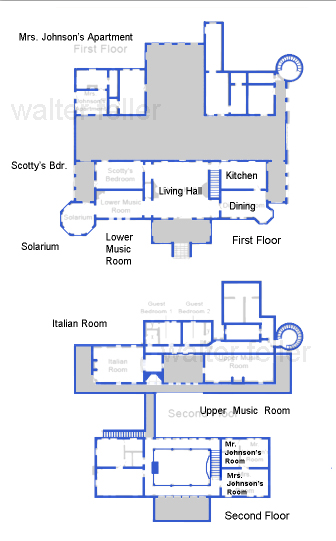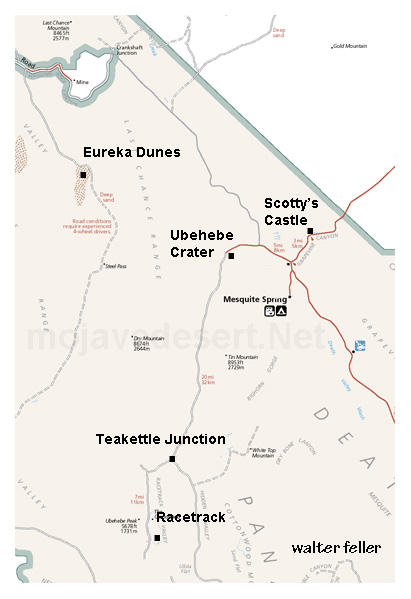SCOTTY'S CASTLE CHRONOLOGY
from; HISTORIC STRUCTURE REPORTDEATH VALLEY SCOTTY HISTORIC DISTRICT
MAIN HOUSE AND ANNEX
September 1991
LAND ACQUISITION AND EARLY DEVELOPMENT
1880s
Land in Upper Grapevine Canyon, on which Scotty's Castle would be built, was originally patented by Jacob Steininger during the 1880s under the provisions of the Desert Land Act of 18711906
Albert M. Johnson and Walter Scott (Death Valley Scotty) made their first journey to the Death Valley region to inspect Scotty's elusive mines.1906-1922
Johnson and Scotty visited the Death Valley area about a half dozen times, the former relishing the climate, scenery, and isolation of the region as well as the companionship of the latter.1915-1917
Johnson began acquiring old homesteads and mining claims in northern Death Valley, including the Steininger Ranch property which he dubbed the "Death Valley Ranch." His holdings, which eventually totaled more than 1,500 acres, were split into two separate parcels about eight miles apart - the Upper and Lower Grapevine ranches. CONSTRUCTION PERIOD1921
Johnson decided to make improvements and construct more civilized accommodations on the Death Valley Ranch.1922
Johnson began developing plans for the ranch and hired Frederick William Kropf as construction superintendent to oversee the improvements.1922-1924
Kropf supervised all facets of construction of the first three structures - a garage, two-story main house, and cook house - before being dismissed in July 1924.1924-1925
Construction of three secondary structures - the stables, chicken coop, and workshop/shed - was commenced using plans developed by Johnson.1925
Matt Roy Thompson was hired as general superintendent for construction in October.1925-1926
Under the direction of Thompson the three secondary structures were completed, and a onestory building, originally known as the "Cellar" but later referred to as the "Commissary," was erected parallel and to the north of the main building.1926-1931
In June 1926 Charles Alexander MacNeilledge was hired to direct the overall planning and design of the Death Valley Ranch complex in a rather unique Spanish hacienda style variously referred to as Spanish Colonial Revival, Spanish Mediterranean, or Spanish Provincial. Between February and August 1931, when construction operations ceased, Martin D. de Dubovay was named to replace MacNeilledge. The position of building superintendent was established during the fall of 1926 and was filled by at least four men between 1926-31: F.X.A. Kreil, H. Brewster Brown, Chris J. Johnson, and W.D. McLean.1929
Dewey R. Kruckeberg was hired as a landscape architect to supervise and direct the landscape design of the ranch.LANDOWNERSHIP ISSUES
1930
On July 25 President Herbert C. Hoover signed Executive Order 5408 withdrawing more than 2,000,000 acres of land from the public domain, pending the outcome of further studies leading toward inclusion of Death Valley in the National Park System. In December Johnson was informed that previous land surveys of the 1880s, upon which his land acquisition endeavors had been based, might be incorrect. Subsequent surveys showed that the land he actually owned was one mile north and one mile west of the property on which he was constructing the castle complex.1931
In August Johnson halted construction operations on the castle complex until his landownership problems could be fully resolved.1933
On February 11 Death Valley National Monument was proclaimed by President Hoover. The monument included Johnson's lands in Grapevine Canyon.1935
On August 22 President Franklin D. Roosevelt signed into law H.R. 2476 permitting Johnson to purchase his lands in Grapevine Canyon from the government at a cost of $1.25 per acre.1937
On November 17 a patent was issued to Johnson for 1,529.83 acres in Grapevine Canyon, thus restoring to him full ownership of the lands that he had originally thought he had acquired. By this time, however, he had lost much of his fortune and could not afford to resume construction.CASTLE COMPLEX, 1930-1947
1926-1930
In 1930 Herman William Eichbaum, who had opened a 38-mile scenic toll road over Towne Pass in the Panamint Range bordering the western approach to Death Valley in May 1926 and had established the Stove Pipe Wells Hotel in November 1927, completed the first improved automobile road north through the valley from his hotel to the Grapevine Canyon area. Earlier in February 1927 the U.S. Borax Company had opened the Furnace Creek Inn some 50 miles south of Grapevine Canyon. The new roads and resort developments encouraged increasing numbers of tourists to visit Death Valley.1930-1931
Increasing tourism to Death Valley led to growing interest in the developments underway in Grapevine Canyon. By April 1930 it was reported that a daily average of 40 to 80 visitors were arriving at the castle complex, and in February 1931 it was noted that holiday weekend visitation was up to 100 visitors per day.Construction was still underway, and the visitors were generally viewed as a nuisance. The tourists were sometimes given impromptu tours by Scotty, but no meals were provided except on rare occasions when Scotty issued special invitations.
1933
As a result of their deteriorating finances the Johnsons moved from Chicago to Hollywood, California. Thereafter, they visited the castle generally on a monthly basis, staying for several days during each visit.1934
During the early 1930s Johnson realized the economic potential of the growing number of visitors to Grapevine Canyon, especially in view of the decline in his personal financial resources. By 1934 tours of the main house and annex were conducted on an informal basis.Johnson also envisioned potential financial value from the sale of postcards and hired Burton Frasher, a professional photographer, to take large format photographs of the castle complex buildings, interiors, and grounds. Frasher specialized in publishing postcards and often stayed at the ranch, taking photographs which he used to produce thousands of postcards for sale at the ranch.
1936-1937
By 1936 several young men and women had been hired and trained as tour guides and security guards for the castle, and an admission price of $1.00 per person was instituted. Bessie Johnson, more so than her husband, administered the tour services and was known to conduct a few herself. During the winter of 1936-37 as many as 130 tourists took the one hour tour per day.1941
In October 1941 guidebooks for the tour of the main house and annex were placed on sale as souvenirs. The guidebooks had been prepared by Bessie Johnson as a training manual for the guides and a memento for the public. In 1941 Johnson had 10,000 of the guidebooks privately published under the business name of the Castle Publishing Company.1942-1945
Gasoline and tire rationing during World Was 11 severely limited tourism and visitation to the castle complex. The decline in visitation resulted in a loss of income from the castle which earlier had amounted to as much as $5,000 per month. Thus, it became more difficult for Johnson to meet the costs of operating and maintaining the castle.1943
On April 22, 1943, Bessie Johnson died as the result of an automobile accident as she and Albert were traveling over Towne Pass, some 40 miles south of Grapevine Canyon. Albert was driving and lost control of the car. Bessie was thrown from the vehicle and died instantly. His sorrow over losing his wife of 47 years, together with his own deteriorating health, made it increasingly difficult for Albert to visit and properly maintain his Death Valley property.CASTLE COMPLEX UNDER ADMINISTRATION OF THE GOSPEL FOUNDATION
1946
Johnson established the Gospel Foundation, a socially oriented charitable organization, to manage his estate. Mary Liddecoat, a long-time family friend, was named president, and Walter Webb, a long-time business associate, became vice president.1947
On May 19 Johnson inserted a provision in his will transferring all his landholdings to the Gospel Foundation upon his death. These included his property in Grapevine Canyon, the Shadelands Ranch near Walnut Creek, California, and the Johnson home in Hollywood, which became the office and headquarters of the foundation.1948
Following the death of Johnson on January 7, the Gospel Foundation announced that it would continue to operate the castle complex as a "museum-hotel," offering regularly scheduled guided tours as well as nightly accommodations for 15-20 guests.CASTLE COMPLEX UNDER ADMINISTRATION OF THE NATIONAL PARK SERVICE
1970
In July the National Park Service purchased the Upper Grapevine and Lower Grapevine ranches, including the castle complex, for $850,000, using funds provided by the Land and Water Conservation Act of 1965. The funds could not be used to purchase the castle furnishings. Thus, the Gospel Foundation donated the furnishings.1973
Between 1970 and 1973 tours, routine cleaning, fire protection, and security at the castle complex were administered by National Parks Concessions, Inc. In 1973 the National Park Service assumed full responsibility for the maintenance and operation of the castle complex.
Clickable Scotty's Castle Area Map
